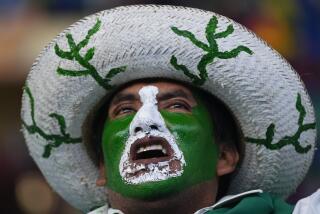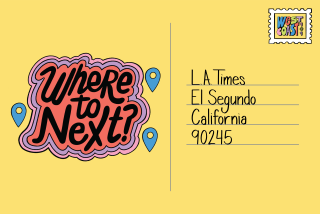Discovering the ‘Wow’ Factor on Bolivia’s Plains
- Share via
UYUNI, Bolivia — We were in northern Chile when our driver pointed to the smooth black asphalt rolling east. “That’s the road to Argentina,” he said. He suddenly turned north onto a rutted piste. “This is the road to Bolivia.”
Andrea and I chuckled nervously, wondering what we’d signed on for, but awe soon replaced apprehension. For three days we bounced over the Bolivian Altiplano, the high, treeless plain stretching between the two ranges of the Andes. The magical 300-mile journey through the remote region gave us the sensation of leaving the planet. By the time we finished in this desert city 275 miles south of La Paz, I’d said “wow” so often my lips were cracked.
The Bolivian border crossing was guarded by a length of pipe atop two metal posts. Waiting on the other side with a four-wheel-drive Toyota Land Cruiser were Roberto, our guide, and his wife, Wilda, our cook. After we were grouped with three European travelers, Roberto made up his own road across the vast plain, flanked by volcanoes, Dali-esque rock formations and mineral-stained mountains. Sulfur spilled down like yellow rivers, flowing onto a basin the colors of coffee, chocolate and cinnamon.
A cloud of steam marked the Sol de Manana geyser patch. We carefully picked our way among the bubbling mud pots, heat radiating through our shoes, flecks of boiling earth splashing our pants. One geyser roared like a jet engine, and I strained to hear Roberto say, “One of these could go off at any minute.” I stopped playing Innocents Abroad and headed for the truck.
We passed flamingo-dotted salt lakes, none more spectacular than Laguna Colorada, where microorganisms dye the water red. The rare James’ flamingos that feed on algae are a vibrant red and pink. They appear as bathers in a sea of blood that laps a snow-white borax shore.
The scenery was not all that took our breath away. We had topped 16,404 feet--nearly 2,000 feet higher than Mt. Whitney--and felt the effects of the thin air. Roberto and Wilda offered us coca tea, the Bolivian cure-all, but we five gringos rode out the night on water and aspirin. None of us could fall asleep in the wind-lashed bunkhouse. The energy it took to roll over made me gasp for air. My head throbbed, and my eyes ached. I was better but still a little disoriented in the morning. When I tried to brush my teeth, I missed and brushed my chin.
The second day took us closer to Andean wildlife. Vizcachas, relatives of the chinchilla, bounded over red volcanic slabs. When we tossed bread to the long-eared, furry rodents, they shared it with mice. Llamas grazed on spongy grass, as did vicunas, their smaller, wild cousins. That night Wilda served llama meat. From the viewfinder to the frying pan. I didn’t have the heart to help myself to seconds.
We rose early the third day to watch the sun rise on Salar de Uyuni, the largest salt flat in the world, about 40 times bigger than Utah’s Bonneville Salt Flats. The blinding white remnants of a prehistoric salt lake stretch so far and wide, you can see the curve of Earth. We felt we were in the Arctic until we reached Isla de Incawuasi, a cactus-covered island standing in the ocean of salt. The island, home to a Bolivian couple, their dog and an eagle named Alberto, boasts cactuses 30 feet tall and 1,500 years old.
Back in the truck, we streaked across the salt pan. Hexagonal ridges formed by the sun tattooed the white crust, so the world now looked like a giant soccer ball. Indeed, the trip was a kick.
NEXT WEEK: Off to prison in La Paz.
*
Did you miss a Wander Year installment? The entire series since it began in January can be found on The Times’ Web site at https://www.latimes.com/travel/wander.
More to Read
Sign up for The Wild
We’ll help you find the best places to hike, bike and run, as well as the perfect silent spots for meditation and yoga.
You may occasionally receive promotional content from the Los Angeles Times.






